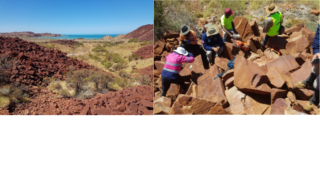Our Research
TIGeR presents its inaugural Festival of Short Courses
Posted 12/10/2022
Last week, to an appreciative audience of visiting international and local students from Curtin and Murdoch Universities, TIGeR presented a series of three educational short course/interactive workshops. Our special thanks to visiting TIGeR alumni, Professors Christine and Andrew Putnis, who together with Dr Raffaella Demichelis, presented their workshop on ‘Fluid-Rock Interaction and its Consequences.’ This was followed by ‘Dates, Rates and Traits: How Isotopes are used in Geology’, presented by members of the Timescales of Mineral Systems Group and John de Laeter Centre. The series concluded with Associate Professor Tim Johnson’s hands-on, computational workshop on ‘Phase Equilibrium Modelling.’

TIGeR researcher named WA Scientist of the Year
Posted 14/09/2022
John Curtin Distinguished Professor Kliti Grice, founding TIGeR member, ARC Laureate Fellow and Director of the WA Organic and Isotope Geochemistry Centre, was recently announced at the annual Premier’s Science Awards as WA Scientist of the Year. Professor Grice was recognised for her outstanding achievements in developing and applying compound-specific isotope analysis methods to studies of mass extinction events that have shaped life on Earth, species adaptation to environmental change, and the role of microbes in exceptional fossil preservation. As a pioneering woman in STEM, the Premier’s award to Professor Grice follows the honour of being an invited speaker at the prestigious Crafoord Prize Symposium in Geosciences in Lund, Sweden in April. Professor Grice will also be a plenary speaker at next year’s TIGeR-sponsored Australian Earth Sciences Convention in Perth.
Fossil plants, animals and their remains reveal ancient environmental conditions and diet
Posted 12/09/2022
The wild canyons and bluffs of Utah and Wyoming hide a secret: some of the best fossils in the world, and in August, TIGeR Research Associate Dr Amy Elson was lucky enough to visit these ancient super-lake deposits and hunt for fossils as part of Professor Kliti Grice’s extreme fossilisation ARC Laureate project (TIGeR News 2021). In exposures of the Green River Formation, Amy found 50-million-year-old intact fish with eyes still preserved, along with insects, plants, fossil-bearing concretions, and mammal bones. An extensive series of imaging techniques along with organic and isotopic analysis is planned for these samples, to better understand the past evolution and environments of these creatures!
Meanwhile, as part of the same project, PhD student Madison Tripp has published the results of her study of organic molecules trapped within the 300-million-year-old fossilised faeces of an unidentified extinct animal, using a sample supplied by the Field Museum, Chicago. Madison’s results, published in a special issue of Biology entitled ‘Paleontology in the 21st Century’, demonstrate that the animal was a carnivore.
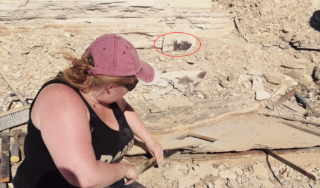
Supervolcanoes, CO2 emissions and climate change
Does size matter when it comes to how deadly supervolcano eruptions are in their effect on the atmosphere and species extinctions? In a new study published in Proceedings of the National Academy of Sciences, TIGeR scientists, led by former TIGeR PhD student Qiang Jiang, accurately dated the world’s second largest Phanerozoic supervolcano, the Kerguelen large igneous province in the Southern Ocean. Using lava samples obtained from the seabed via the International Ocean Drilling Program, they showed that its voluminous eruptions ~120 million years ago barely made a dent in Earth’s life and climate. The key to understanding its relatively benign environmental impact was provided by analysis of the composition of melt inclusions in the lavas which indicated that the rate of CO2 emissions at Kerguelen was very much lower than for other, more deadly supervolcanoes in the geological record.
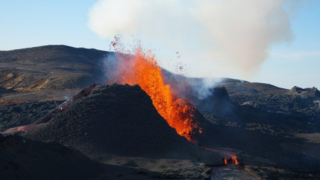
Art and geology intersect on new collaboration
In an exciting new collaboration, renowned artist Janet Laurence and John Curtin Distinguished Professor Pete Kinny have teamed up to create a unique, geologically themed art installation. Composed of more than 150 individual rock and minerals specimens sourced from all parts of Western Australia, and encompassing all geological periods, the rocks float above a wall four storeys high in the central atrium of building 418 on Curtin’s Bentley campus – the newly-completed home of the School of Design and the Built Environment. Numerous individuals and organisations kindly donated pieces for the exhibit, including the WA Museum and WA Geological Survey.
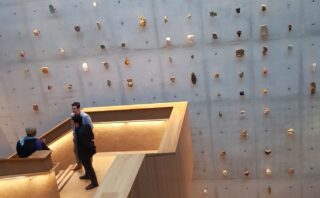
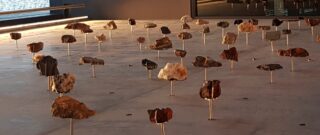
Why geological field work is so amazing – meteorite find at Jack Hills
Geological field work is amazing because you never know what you will find! Last year former TIGeR director Professor Simon Wilde led a field party to the Jack Hills in WA’s mid-west to visit the famous localities in which the world’s oldest minerals (zircons over 4 billion years old) have been found. Unexpectedly, while inspecting outcrops of the ancient bedrock, one of the party, Research Fellow Dr Leonid Shumlyanskyy, found a large iron meteorite of unknown origin lying on the ground. The meteorite is quite big, weighing 12.5 kg. Besides being composed predominantly of Ni-Fe alloy, it contains chromite nodules and numerous aggregates of Fe-Ni sulfides. An extensive program of geochemical, isotopic and mineralogical studies has been designed to better understand the meteorite’s origin.
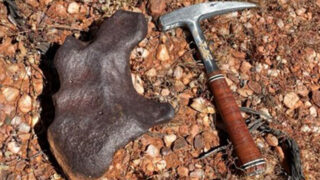
TIGeR cubs field trip to the Great Southern
Posted 3 March 2022
On a cold and wet weekend last September, a happy troupe of TIGeR HDR students set out to visit the Porongurup and Stirling Ranges in the Great Southern region of WA on a TIGeR sponsored field trip. Strictly speaking that’s a ‘streak’ of TIGeR cubs. In the words of organiser and field leader Dr Hugo Olierook, “We learned a little geology, we took in Western Australia’s natural beauty, and we formed some lifelong friendships. Job well done if you ask me”.
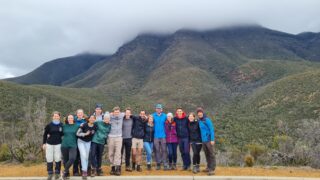
Murujuga rock art monitoring project underway
Posted 10 March 2022
The arid, rocky landscape of the Burrup Peninsula and Dampier Archipelago in Western Australia’s Pilbara region is one of the richest repositories of prehistoric petroglyphs in the world. Existing alongside modern industry, there are ongoing efforts to preserve the precious rock art from potentially accelerated decline due to atmospheric emissions. Awarded in 2021 by the WA Government’s Department of Water and Environmental Regulation, an extensive monitoring program is being developed and implemented to provide statistically robust information on the condition of the rock art surfaces and causes of any detectable change. This will guide the management plan for the area, which is proposed for World Heritage listing. The first stage of site selection and documentation was completed late last year, with TIGeR geoscientists Katy Evans, Pete Kinny and Jack Gillespie working alongside archaeologists, project engineers, statisticians, indigenous Elders and Murujuga Aboriginal Corporation rangers to select geologically representative and culturally appropriate sample localities for inclusion in the study. Numerous other TIGeR members will be playing key roles in the analytical programs to follow, in what will be a major, multi-year interdisciplinary project.
